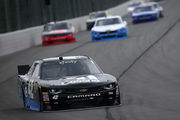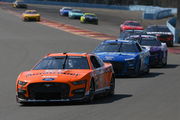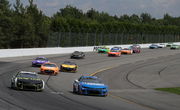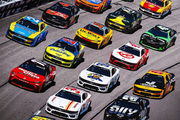
USA Today via Reuters
Apr 16, 2023; Martinsville, Virginia, USA; NASCAR Cup Series driver Daniel Suarez (99) and NASCAR Cup Series driver Ryan Preece (41) lead the pack to a restart during the NOCO 400 at Martinsville Speedway. Mandatory Credit: John David Mercer-USA TODAY Sports

USA Today via Reuters
Apr 16, 2023; Martinsville, Virginia, USA; NASCAR Cup Series driver Daniel Suarez (99) and NASCAR Cup Series driver Ryan Preece (41) lead the pack to a restart during the NOCO 400 at Martinsville Speedway. Mandatory Credit: John David Mercer-USA TODAY Sports
Horsepower is one of the main factors that sets a high-performance stock racing car apart from a Hyundai. Ever since NASCAR introduced the next-gen car in 2022, it has faced both appreciation and backlash for its new features. One of the prime reasons for the latter was the horsepower limits that it had inked in its rulebook. Two full seasons of racing in the next-gen later, drivers continue to raise their voices in unison demanding an increase in horsepower.
But what is it with the imposed limits that is so bad that the drivers who are usually at loggerheads with each other, now stand together against NASCAR? Let’s push the rewind button to understand.
ADVERTISEMENT
Article continues below this ad
NASCAR’s change in horsepower package and the problem with it
The opposition that the promotion faces in regard to horsepower reduction is not newfound. Ever since the use of tapered spaces brought down engine capability from 900 HP to 750 HP in 2015, fans and drivers haven’t seen eye-to-eye with NASCAR. Things were made worse when the power was curbed further to 550 HP in 2019. It was at a time when these limits had marred on-track performance displays for several seasons that the next-gen car was introduced.
Before the 2022 season debuted, NASCAR had begun testing the next-gen car to determine its technical configurations. After a chaotic field test at the Charlotte Speedway in November 2021 where drivers were not pleased with the horsepower that was beneath the cars’ hoods, officials agreed to move up the base from its usual 550 HP to 670 HP. But even this increase has proven to be futile as time has proven.
The problem with NASCAR’s 550 HP engine, which had been in use since 2019, was that it allowed for fewer passing opportunities and slower lap times. The higher bandwidth in power has done little to change that and it is still nowhere near the original close-to-1000 HPs that used to be. The authoritative words of legend Richard Petty that came before the 2023 Daytona 500 sum up the stagnancy of the issue. He said, according to an Autoweek report, “One car can’t do anything. If somebody pulls out, they have to have help because they don’t have any horsepower. You pull out of line and go forward… It’s a real c**pshoot. I feel sorry for the drivers that have to drive right now.”
Trending
Reasoning behind NASCAR being reluctant to bump up engine power
There are quite a few sensible reasons for the promotion not readily just throwing in a couple hundred more horsepower into its engines. Taking center stage amongst that is that it wants to encourage newer manufacturers to enter the scene. In the words said to NBC Sports by the promotion’s chief racing development officer John Probst, “We’re not hiding from the fact that we would like to encourage some new (manufacturers) to come in. That is part of the equation for that whole thing. I’m not saying it’s the driving reason, but it is a consideration.” Probst’s point was that the current horsepower range enables the use of pre-designed engines, which in turn could benefit new manufacturers. Lower horsepower also translates into engine longevity and thus, reduced running costs for teams.
The reluctance of having more horsepower than the 670hp (with the tapered spacer) is it likely requires research/development on parts/pieces for performance & so they can go the mileage needed to last two races. That is a cost that NASCAR/teams/manufacturers hope to avoid. https://t.co/8ZkaPB4cDf
— Bob Pockrass (@bobpockrass) January 9, 2023
While the change has catapulted the racing experience in intermediate tracks to a never seen before high, it has also taken short-track races to a new low. Parallely, it was after the Cup Series race at the Martinsville short-track in April 2023, that the demands began popping out once again from those behind the wheel. Talking about the difficulty in adding horsepower to tackle the short-track problems, NASCAR’s SVP of competition, Elton Sawyer said to SiriusXM NASCAR Radio, “If there are other options outside the engine it would be far easier for us to pull that lever. I’m not saying it isn’t a good option down the road [Increasing horsepower], but it takes a little longer runway to get there.”
Despite the justifications, it is for providing an enthralling racing experience that NASCAR exists. With the idea that a higher horsepower means drivers will have more control and the ability to race better gaining momentum by the day, prominent voices have joined in with the 2024 season drawing closer.
Watch Story: Electrifying the Track: NASCAR’s Secret EV Revolution
The rise of voices demanding horsepower to be increased
Ever since the 2023 NOCO 400 at Martinsville, several industry stalwarts have asked for an increase in horsepower. The first voice to come out this year was that of the former champion Joey Logano. He talked to NBC Sports after finishing runner-up in the race, “There’s just not enough speed difference in the cars. They’re almost the same. There’s not much fall-off. We need more fall-off, and we need a lot more horsepower.”
Talking about the problem in his own pessimistic fashion, Denny Hamlin said on his podcast, “Stop asking NASCAR for more [horsepower], they’re not going to give it to you. This is not the direction NASCAR wants to go. From the top down, they don’t want more horsepower because it costs more money. (…) If anything, they will go the other way, and make the engines even less powerful because they want them to run even more races.”
It has become obvious that the next-gen car simply does not produce good enough performances at tracks like Martinsville and North Wilkesboro. NASCAR has worked with Goodyear and its engineers to try various remedies but they have all been in vain. All that the drivers on the grid ask of the promotion now is that it “tries” out increasing the horsepower. Dale Earnhardt Jr delved in an episode of ‘Dale Jr Download’, “NASCAR has a serious problem with the NextGen Car at the short tracks, any short tracks… I am putting something on NASCAR here, man. I am really trusting them and hoping that they’re gonna fix this. They got to.”
ADVERTISEMENT
Article continues below this ad
With many more drivers and crews voicing their frustrations with the limitations that the next-gen car’s horsepower is putting on them, the retired hero Kevin Harvick has added strength to the movement. Talking to Dale Jr, he gave his take saying, “We (used to get) out of the car and they were making 1000 horsepower and today they make 750, mufflers on them, less. (…) I wish they would just try it but I know it’s a big undertaking.” In response to Harvick, Junior once again underlined his stand saying that he wanted to see the car pushed to its limit.
View this post on Instagram
ADVERTISEMENT
Article continues below this ad
In response to all the concerns that have been surrounding the short-track issues in 2023, NASCAR executive Steve O’Donnell noted in the 2023 annual State of the Series address that “everything is up for consideration” in order to solve the situation, including a power increase. As talks and discussions over horsepower continue, drivers and NASCAR prepare for yet another short track test at Phoenix in December. Hopefully, what the promotion sees at the track test will push them to take the engine power back the way of 2014 levels.
ADVERTISEMENT
ADVERTISEMENT
ADVERTISEMENT
ADVERTISEMENT






